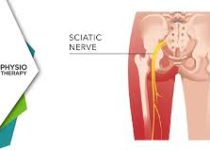What Causes Sciatic Nerve Pain? A Comprehensive Overview

Sciatic nerve pain, commonly referred to as sciatica, is a condition that affects millions of people worldwide. It occurs when the sciatic nerve, which is the largest nerve in the body, becomes compressed or irritated. This can lead to a range of symptoms, including sharp pain, tingling, numbness, and weakness in the legs. Understanding the underlying causes of sciatic nerve pain is crucial for effective treatment and management. In this article, we will explore the various factors that can lead to sciatica, how they affect the nerve, and what you can do to alleviate the pain.
Thank you for reading this post, don't forget to subscribe!Understanding the Sciatic Nerve
Before diving into the causes, it’s essential to understand the sciatic nerve’s anatomy. The sciatic nerve originates from the lower back (lumbar spine) and runs through the buttocks and down the back of each leg. It branches off into smaller nerves that innervate different parts of the legs and feet. Because of its size and the area it covers, any irritation or injury to this nerve can cause significant discomfort.
Common Causes of Sciatic Nerve Pain
1. Herniated Discs
One of the most common causes of sciatica is a herniated or bulging disc in the lumbar spine. The discs act as cushions between the vertebrae and can become damaged due to age, injury, or strain. When a disc herniates, the soft inner material can protrude and compress the sciatic nerve. This compression can lead to sharp pain that radiates down the leg.
2. Spinal Stenosis
Spinal stenosis occurs when the spinal canal narrows, putting pressure on the spinal cord and nerves, including the sciatic nerve. This condition is often age-related, as the discs and joints can degenerate over time. Symptoms may include pain, numbness, and weakness, especially when standing or walking.
3. Degenerative Disc Disease
As people age, the spinal discs naturally lose hydration and elasticity, which can lead to degenerative disc disease. This condition can result in reduced disc height and increased pressure on the sciatic nerve, causing pain and discomfort.
4. Spondylolisthesis
Spondylolisthesis is a condition where one vertebra slips out of place over another. This misalignment can compress the sciatic nerve and lead to significant pain. It often occurs in the lower back and can be the result of age-related degeneration, injury, or genetic factors.
5. Muscle Strain or Injury
Injuries or strains to the lower back, hips, or leg muscles can aggravate the sciatic nerve. For example, a muscle spasm in the piriformis muscle (located in the buttocks) can irritate the nerve. This condition is sometimes referred to as piriformis syndrome and can result in pain that mimics sciatica.
6. Trauma or Injury
Any trauma to the lower back or pelvis, such as from a fall, car accident, or sports injury, can lead to sciatica. In these cases, the nerve may be directly impacted or inflamed due to surrounding tissue damage.
7. Skeletal Irregularities
Certain skeletal conditions, such as scoliosis (abnormal curvature of the spine), can increase the risk of sciatica. These irregularities can alter the alignment of the spine, leading to nerve compression.
8. Pregnancy
Pregnancy can also contribute to sciatic nerve pain. As the body undergoes significant changes, including weight gain and hormonal shifts, the sciatic nerve may become compressed. Additionally, the position of the growing fetus can put pressure on the nerve.
9. Obesity
Excess weight can contribute to sciatica by putting additional stress on the spine and nerves. The added pressure can lead to degeneration of the discs and other spinal structures, increasing the risk of nerve compression.
10. Diabetes
Diabetes can lead to nerve damage and a condition known as diabetic neuropathy, which can affect the sciatic nerve. High blood sugar levels can lead to inflammation and nerve damage over time.
Symptoms of Sciatica
Understanding the symptoms associated with sciatic nerve pain is crucial for early diagnosis and treatment. Common symptoms include:
- Radiating Pain: Pain that starts in the lower back and radiates down the leg, often described as sharp, burning, or electric shock-like.
- Numbness and Tingling: A pins-and-needles sensation in the leg or foot.
- Muscle Weakness: Difficulty in moving the leg or foot, which can impact mobility.
- Aggravation with Movement: Pain may worsen with activities like sitting, standing, or twisting.
Diagnosis and Treatment
If you suspect you have sciatica, it’s essential to consult with a healthcare provider. They will conduct a physical examination and may order imaging tests, such as X-rays or MRIs, to determine the underlying cause.
Treatment Options
- Physical Therapy: A physical therapist can develop a personalized exercise program to strengthen the muscles supporting the spine.
- Medications: Over-the-counter pain relievers, such as NSAIDs, can help manage pain and inflammation.
- Chiropractic Care: Adjustments may relieve pressure on the sciatic nerve.
- Surgery: In severe cases, surgical intervention may be necessary to relieve nerve compression.
Conclusion
Sciatic nerve pain can stem from various causes, ranging from herniated discs to muscle strains. Understanding these causes is crucial for effective treatment and management. If you experience symptoms of sciatica, consult a healthcare provider for an accurate diagnosis and tailored treatment plan. By addressing the root causes of the pain, you can work towards relief and improved quality of life.
thyrovanz Official Sitethyrovanz Buy Nowthyrovanz Supplementthyrovanz VitaminsAmazon thyrovanzthyrovanzthyrovanz Supplementthyrovanz Buy Now


